

 The South African
The South African
The Battle of Square Hill was the climax of the involvement of the 1st Bn Cape Corps in the First World War (1914-1918). Although the unit was specifically formed for combatant service during the war, the Cape Corps can trace its ancestry back to the Pandour Corps raised during the Dutch occupation of the Cape and to the Cape Regiment and Cape Mounted Rifles formed in the eighteenth century after Britain had seized control of the Cape.
At the onset of the First World War, Cape Coloured auxiliary units were formed for service in the German South West African campaign. These units provided artillery and transport drivers, mechanics, officers' batmen and various other non-combatants for the campaign. After the surrender of the German protectorate, the South African Government, under the leadership of Prime Minister Gen Louis Botha, took a decision to raise a unit of coloured troops for combat service in the German East Africa campaign. The decision was a bold one as government policy at the time stipulated that only white males could be used in a combatant capacity. It was made easier by the fact that all units raised in South Africa for service in East Africa would be Imperial service units paid for by the British Government.
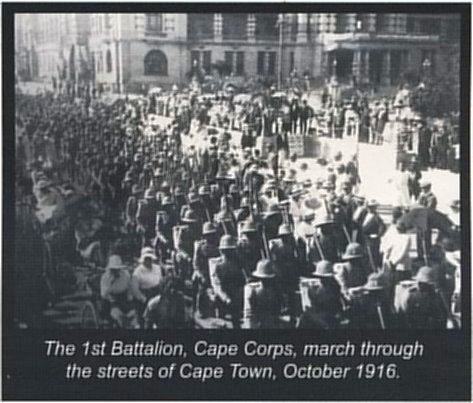
The 1st Bn Cape Corps served in German East Africa from February 1916 to December 1917 and suffered 163 men killed in action. Eleven Distinguished Conduct Medals, seven Military Medals and two Belgian decorations for bravery were awarded to personnel of the Battalion during this period. Recruiting for the 1 st battalion had been so successful that a second battalion Cape Corps was formed in June 1917. This battalion served in East and Central Africa until July 1918.
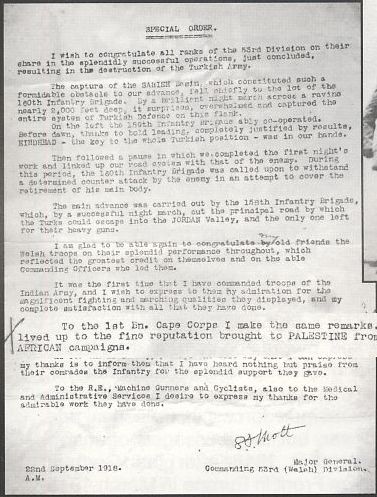
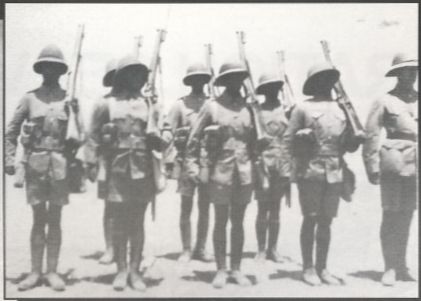
After their return to South Africa at the end of 1917, the 1st Bn Cape Corps received news that the British Army Council intended to reorganise the unit for service in another theatre of the war. It was sent to the Middle East where it formed part of the Egyptian Expeditionary Force under the cornmand of Gen Sir Edmund Allenby. Allenby's Force had been clearing the southern part of Palestine of Turkish Ottoman forces and, by the end of 1917, had taken Jerusalem and dug in along a strong defensive line north of the ancient city. The next step, planned for early 1918, was to crush the remaining Ottoman forces in Palestine and force Turkey out of the war, but the envisaged offensive was postponed to September 1918 after the German offensive along the Western Front in Europe in March 1918 brought a number of British and Imperial units allocated to the Middle East, back to Europe to reinforce the British armies that were floundering on that front.
In the meantime, the 1st Bn Cape Corps landed in Egypt in April 1918 and spentthe following two months training. The Battalion was then placed under the command of British 160th Brigade which formed part of the 53rd Welsh Division. The other units of the Brigade were the 1st/17th Bn Royal Welsh Fusiliers, 1st/17th (Loyal) Indian Infantry and the 1st/7th Bn Punjabi Regiment. Although the men of the Cape Corps were well-nourished and clothed, early strains of the devastating Spanish influenza epidemic had begun to take its toll on the Battalion and, by September 1918, it could only maintain about 70% of its complement.
When the offensive eventually got underway on 18 September, the 53rd Division formed part of a force assigned to attack the Turkish positions north-east of Jerusalem through the Nablus Valley and the Jordan Valley. The 1st Bn Cape Corps was tasked to follow the 1st/17th Bn Punjabi Regiment and march along the watershed to take Dhib Hill, Chevron Hill, Crest Hill, End Hill and Square Hill with pickets being dropped along the route to protect the right flank of the advance. On arrival at Dhib and Square hills, the Battalion was to be responsible for protecting the right flank of the 160th Brigade against counter-attack from the east. The plan was that once the 1st/17th Sn Royal Welsh Fusiliers had signalled the capture of Hill 2362, Cape Corps detachments would be pushed forward to capture a high ground position known as Kh Jibeit.
The Battalion attacked Square Hill at 18:45 on 18 September with the men acquitting themselves admirably after an intense artillery bombardment. They achieved their objective early on 19 September with the loss of one dead and one wounded. During the attack, 180 Turkish soldiers and one gun were captured.
North of Square Hill, the retreating Turkish troops dug in strongly on Kh Jibeit and, instead of advancing safely along either flank to isolate the position and cut off the defending forces, the Battalion was ordered to capture it by 07:30 on 20 September. An earlier reconnaissance probe had suggested that, although the enemy strength in front of the Battalion was unknown, it was not considerable. The Battalion attack, set for 03:00, was to be preceded by a strong artillery bombardment of five minutes.
However, the attack did not go according to plan, beginning with the artillery bombardment, which started late and, once it got going, lacked accuracy, giving the Turks time to reinforce their defences. The order to attack was finally given at 05:00 which meant that the objective would only be reached in daylight. Almost immediately the men of the Cape Corps were met with terrific machine gun fire and the attacking force was broken up, suffering heavy casualties. By the time they were ordered back to Square Hill, all the officers had been lost and thus the retirement had to be effected by NCOs. This was done in an orderly and disciplined manner and by 23:00 on 20 September the Battalion was back at Square Hill. It comprised only ten officers and 350 men, having suffered 51 killed, 101 wounded and one person taken prisoner.
After the offensive against the Ottoman Turks, the 1st Bn Cape Corps was withdrawn to Alexandria where it remained until returning to South Africa in September 1919. For their actions at Square Hill and Kh Jibeit, members of the Battalion earned a Military Cross, a Distinguished Conduct Medal and five Mentioned in Despatches. The dead lie buried in the Jerusalem War Cemetery north of the city while the gun captured at Square Hill was brought back to South Africa where it became the focal point of the Square Hill Memorial in Kimberley in the Northern Cape.
On 21 September 2014, the Square Hill service followed the traditional programme of commemoration and wreath-laying. Guests included members of various military veterans associations, including the Cape Corps Veterans Association, members of the City of Johannesburg Metropolitan Council and senior officers of the South African National Defence Force. During the service attention was drawn to the fact that, while 19 September is celebrated as the day the troops went into battle at Square Hill, it is 20 September that is remembered as the day on which the men of the 1st Bn Cape Corps made their sacrifice during the First World War. Bill Nasson echoed this thought when he wrote: 'The Battle of Square Hill of 19 September 1918 was a signal success, coolness under fire and victory unscathed. What translated into Cape Corps heroism in the Great War was the bitter clash of 20 September, the struggle of Square Hill or thereabouts which left their sacrifice of real blood, a mound of dead and medals for bravery.'
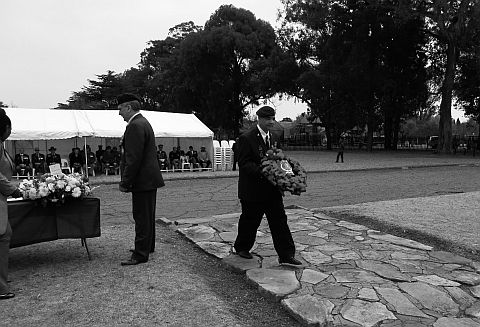
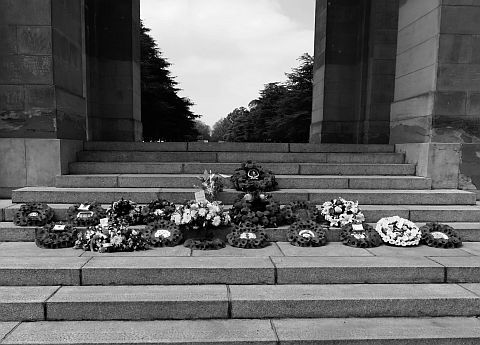
The Battle of Square Hill is recognised as an important battle in the military history of South Africa and the South African National Defence Force has highlighted it as one of four major commemorations which form part of its programme for the centenary of the First World War. A delegation from the SANDF will therefore be travelling to the Middle East to commemorate the centenary of the battle in September 2018.
Bibliography
Difford, I D, The Story of the 1st Battalion Cape Corps (Cape Town, Hortors, 1923).
Nasson, B, Springboks on the Somme: South Africa and the Great War 1914-1918 (Johannesburg, Penguin, 2007).
The War Graves of the British Empire: Palestine and Syria (London, Imperial War Graves Commission, 1924-32).
Battle of Square Hill (programme pamphlet produced by the South African Legion of Military Veterans for the Commemoration Service held on 21 September 2014).
Return to Journal Index OR Society's Home page
South African Military History Society / scribe@samilitaryhistory.org